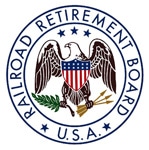
The following questions and answers provide information about the RRB’s performance in the key areas of retirement applications, survivor applications, disability applications and payments, and railroad unemployment and sickness benefit applications and claims during fiscal year 2018 (October 1, 2017 – September 30, 2018). Included are the customer service performance goals the RRB set for fiscal year 2018. These goals may be revised annually based on such factors as projected workloads and available resources. Also included is information on the RRB’s overall performance, as measured by the timeliness index developed by the agency.
1. How does the RRB measure overall timeliness for customer service?
The RRB developed an index to measure overall timeliness of its customer service in four benefit areas: retirement applications; survivor applications; disability applications and payments; and railroad unemployment and sickness benefit applications and claims. This composite indicator, based on a weighted average, allows for a more concise and meaningful presentation of its customer service efforts in these benefit areas.
2. How timely, overall, was the customer service provided by the RRB in fiscal year 2018, as measured by this timeliness index?
During fiscal year 2018, the overall benefit timeliness index was 98.8 percent. This means that the RRB provided benefit services within the timeframes promised in the customer service plan 98.8 percent of the time. The timeliness index for retirement applications, survivor applications, disability applications and payments only, the processing of which includes considerable manual intervention, is 91.4 percent, whereas the timeliness index for railroad unemployment and sickness benefit applications and claims only, a highly automated process, is 99.9 percent. More detailed performance information for specific benefit areas is presented in the questions and answers that follow.
3. What standards were used by the RRB in fiscal year 2018 for processing applications for Railroad Retirement annuities and how well did it meet those standards?
Under RRB’s standards, if you filed an application for a Railroad Retirement annuity in advance, the RRB will make a decision to pay or deny the application within 35 days of the beginning date of your annuity. If you have not filed in advance, the RRB will make a decision within 60 days of the date you filed your application.
Of the cases processed during fiscal year 2018, the RRB made a decision within 35 days of their annuity beginning dates on 94.9 percent of applicants who filed in advance. The average processing time for these cases was 14.7 days.
Also, of the cases processed during fiscal year 2018, the RRB made a decision within 60 days of their filing dates on 96.5 percent of applicants who had not filed in advance. In these cases, the average processing time was 21.1 days.
The RRB’s goals in fiscal year 2018 were 94 percent timeliness both for persons filing in advance and persons not filing in advance.
4. What standards were used in the area of survivor benefits in fiscal year 2018?
Under the standards, if you filed for a Railroad Retirement survivor annuity and you were not already receiving benefits as a spouse, the RRB will make a decision to pay, deny or transfer your application to the Social Security Administration within 60 days of the beginning date of your annuity or the date the application is filed, whichever is later. If you are already receiving a spouse annuity, the RRB will make a decision to pay, deny or transfer your application for a survivor annuity to the Social Security Administration within 30 days of the first notice of the employee’s death. If you filed for a lump-sum death benefit, the RRB will make a decision to pay or deny your application within 60 days of the date the application is filed.
Of the cases considered during fiscal year 2018, the RRB made a decision within 60 days of the later of the annuity beginning date or the date the application was filed in 96.2 percent of the applications for an initial survivor annuity. In cases where the survivor was already receiving a spouse annuity, a decision was made within 30 days of the first notice of the employee’s death in 96.5 percent of the cases. In addition, a decision was made within 60 days of the date the application was filed in 98.2 percent of the applications for a lump-sum death benefit. The combined average processing time for all initial survivor applications and spouse-to-survivor conversions was 12.95 days. The average processing time for lump-sum death benefit applications was 10.2 days.
The goals for fiscal year 2018 were 94 and 93.5 percent timeliness, respectively, for processing initial survivor applications and spouse-to-survivor conversions. For processing applications for lump-sum death benefits, the goal was 97 percent.
5. What standards were used by the RRB in fiscal year 2018 for processing applications for disability annuities under the Railroad Retirement Act?
Under the customer service plan, if you filed for a disability annuity, the RRB will make a decision to pay or deny a benefit within 100 days of the date you filed your application. If it is determined that you are entitled to disability benefits, you will receive your first payment within 25 days of the date of the RRB’s decision, or the earliest payment date, whichever is later.
Of the cases processed during fiscal year 2018, the RRB made a decision within 100 days of the date an application was filed on 11.3 percent of those filing for a disability annuity. The average processing time was 330.9 days. Of those entitled to disability benefits, 91.5 percent received their first payment within the Customer Service Plan’s time frame. The average processing time was 12.8 days.
The agency’s goals were 70 percent and 93.5 percent timeliness, respectively, for disability decisions and disability payments.
6. What were the standards for the handling of applications and claims for railroad unemployment and sickness benefits and how well did the RRB meet these standards?
Under the standards, if you filed an application for unemployment or sickness benefits, the RRB will release a claim form or a denial letter within 10 days of receiving your application. If you filed a claim for subsequent biweekly unemployment or sickness benefits, the RRB will certify a payment or release a denial letter within 10 days of the date the RRB receives your claim form.
During fiscal year 2018, 99.5 percent of unemployment benefit applications sampled for timeliness and 99.3 percent of sickness benefit applications processed met the RRB’s standard. Average processing times for unemployment and sickness benefit applications were 0.8 and 1.9 days, respectively.
In addition, 99.9 percent of subsequent claims processed for unemployment and sickness benefits met the RRB’s standard for fiscal year 2018. The average processing time for claims was 4.3 days.
The agency’s goals for processing unemployment and sickness applications in fiscal year 2018 were, respectively, 99.5 and 99.3 percent timeliness. The payment or decision goal for subsequent claims was 98 percent timeliness.
7. How did the RRB’s performance in meeting its standards in fiscal year 2018 compare to its performance in fiscal year 2017?
Fiscal year 2018 performance met or exceeded fiscal year 2017 performance in the areas of retirement benefits not filed in advance, spouse-to-survivor conversions, lump-sum death benefit applications, and unemployment and sickness benefit claims.
Average processing times in fiscal year 2018 equaled or improved fiscal year 2017 processing times in the areas of Railroad Retirement applications filed in advance, initial survivor applications, spouse-to-survivor conversions, unemployment applications and unemployment and sickness benefit claims. Also, for fiscal year 2018, the agency met or exceeded all of the customer service performance goals it had set for the year, except in the areas of disability decisions and disability payments.
8. Can beneficiaries provide feedback to the RRB about the service they receive?
A customer assessment survey form allowing beneficiaries to evaluate the service they received and suggest how the agency can improve its service is available in every field office. Persons not satisfied with the service they received may also contact the manager of the office with which they have been dealing.
 Chorle’s confirmation would fill a vacancy that was created in August 2015 by the retirement of Michael Schwartz after Schwartz’s 12 years as RRB chairman.
Chorle’s confirmation would fill a vacancy that was created in August 2015 by the retirement of Michael Schwartz after Schwartz’s 12 years as RRB chairman.